
Tipu Sultan commonly referred to as Sher-e-Mysore or "Tiger of Mysore", was a ruler of the Kingdom of Mysore based in South India. He was a pioneer of rocket artillery. He expanded the iron-cased Mysorean rockets and commissioned the military manual Fathul Mujahidin. The economy of Mysore reached a zenith during his reign. He deployed rockets against advances of British forces and their allies during the Anglo-Mysore Wars, including the Battle of Pollilur and Siege of Srirangapatna.
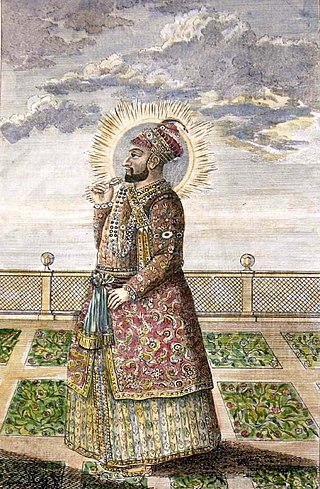
Hyder Ali was the Sultan and de facto ruler of the Kingdom of Mysore in southern India. Born as Hyder Ali, he distinguished himself as a soldier, eventually drawing the attention of Mysore's rulers. Rising to the post of Dalavayi (commander-in-chief) to Krishnaraja Wodeyar II, he came to dominate the titular monarch and the Mysore government. He became the de facto ruler, King of Mysore as Sarvadhikari by 1761. During intermittent conflicts against the East India Company during the First and Second Anglo–Mysore Wars, Hyder Ali was the military leader.

The Maratha Confederacy, also referred to as the Maratha Empire, was an early modern polity in the Indian subcontinent. It comprised the realms of the Peshwa and four major independent Maratha states often subordinate to the former. It was established in 1674 with the coronation of Shivaji as the Maratha Chhatrapati and recognised by Emperor Bahadur Shah I as a tributary state in 1707 following a prolonged rebellion. Following this, the Marathas continued to recognise the Mughal emperor as their nominal suzerain, similar to other contemporary Indian entities, though in practice, imperial politics at Delhi were largely influenced by the Marathas between 1737 and 1803.
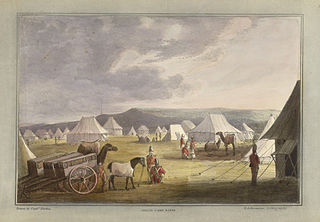
The Third Anglo-Maratha War (1817–1819) was the final and decisive conflict between the British East India Company and the Maratha Confederacy in India. The war left the Company in control of most of India. It began with an invasion of Maratha territory by British East India Company troops, and although the British were outnumbered, the Maratha army was decimated. The troops were led by Governor General Hastings, supported by a force under General Thomas Hislop. Operations began against the Pindaris, a band of Muslim mercenaries and Marathas from central India.

The First Anglo-Maratha War (1775–1782) was the first of three Anglo-Maratha Wars fought between the British East India Company and Maratha Confederacy in India. The war began with the Treaty of Surat and ended with the Treaty of Salbai. The war, fought in between Surat and Poona, saw British defeat and restoration of positions of both the parties before the war. Warren Hastings, the first Governor-General of Bengal decided not to attack Pune directly.

Madhavrao I was the son of Peshwa Balaji Bajirao and grandson of Peshwa Bajirao I who served as 9th Peshwa of the Maratha Confederacy. During his tenure, the Maratha Confederacy recovered from the losses suffered during the Third Battle of Panipat, an event known as the Maratha Resurrection.

The First Anglo-Mysore War (1767–1769) was a conflict in India between the Sultanate of Mysore and the East India Company. The war was instigated in part by the machinations of Asaf Jah II, the Nizam of Hyderabad, who sought to divert the company's resources from attempts to gain control over the Northern Circars.

The Anglo-Mysore Wars were a series of four wars fought during the last three decades of the 18th century between the Sultanate of Mysore on the one hand, and the British East India Company, Maratha Empire, Kingdom of Travancore, and the Kingdom of Hyderabad on the other. Hyder Ali and his succeeding son Tipu fought the wars on four fronts: with the British attacking from the west, south and east and the Nizam's forces attacking from the north. The fourth war resulted in the overthrow of the house of Hyder Ali and Tipu, and the dismantlement of Mysore to the benefit of the East India Company, which took control of much of the Indian subcontinent.
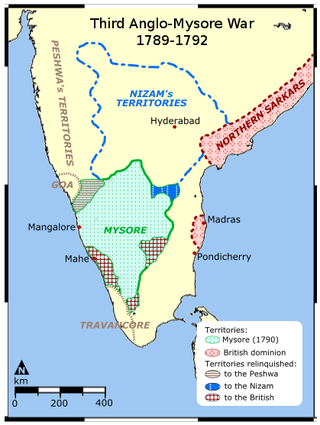
The Third Anglo-Mysore War (1790–1792) was a conflict in South India between the Kingdom of Mysore and the British East India Company, the Kingdom of Travancore, the Maratha Confederacy, and the Nizam of Hyderabad. It was the third of four Anglo-Mysore Wars.
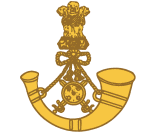
The Maratha Light Infantry is a light infantry regiment of the Indian Army. It traces its lineage to the Bombay Sepoys, raised in 1768, making it the most senior light infantry regiment in the Indian Army.
The siege of Darwar was a twenty-nine-week siege of the fort at Dharwad in 1790 and 1791, then near the frontier, between the Kingdom of Mysore and the Maratha Empire. The Marathas, assisted by forces of the British East India Company, began the siege on 18 September 1790 and resulted with the surrender of Mysore garrison on 3 April 1791.
The Capture of Shimoga, a town and fortress held by forces of the Kingdom of Mysore, occurred on 3 January 1792, after a preliminary battle with the attacking forces of the British East India Company and the Marathas, not far from the town on 29 December, had scattered much of its defending army. The defenders surrendered after the fort's walls were breached. The battle was part of a campaign during the Third Anglo-Mysore War by Maratha leader Purseram Bhow to recover Maratha territories taken by Hyder Ali in an earlier conflict between Mysore and the Marathas. By the end of the siege, Reza Sahib a leading Mysore commander, was among the captured.

Bhairavgad is a fort in India, twenty miles south-west of Patan, Satara district of Maharashtra. The fort is situated on a peak of Sahyadri range. The fort has a temple of Bhairav (Shiva); from which it gets its name. It is located at an altitude of about 1000 meters.
The Maratha–Mysore wars were a conflict in the 18th century India between the Maratha Confederacy and the Kingdom of Mysore. Though initial hostilities between the sides started in 1760s, the last battle began in February 1785 and ended in 1787.
James Hartley (1745–1799) was a British officer in the service of the East India Company. His employment was mainly in the company's wars against the Maratha Empire, and against Tipu Sultan of the Kingdom of Mysore.

The Afghan–Maratha War was fought between the Afghan Empire under Ahmad Shah Durrani and the Maratha Confederacy and the Sikh Confederacy between 1758 and 1761. It took place in north-west India, primarily the region around Delhi and Punjab.
The Battle of Saunshi was fought between the Kingdom of Mysore and the Maratha Confederacy in 1777. Hyder Ali attempted to try to regain his lost territories of Malabar and Coorg from the Marathas and was successful in doing so. Hyder Ali decided to attack the Marathas at Saunshi. Hyder Ali sent his trusted general Muhammad Ali to attack the Maratha garrison stationed at Saunshi. The result of the battle was a decisive victory for Mysore and Hyder Ali against the Maratha forces. Maratha Chief Konher Rao was killed in the battle and Pandurang Rao was captured and taken as a prisoner by the Mysore forces.

The Maratha Navy was the naval wing of the armed forces of the Maratha Confederacy, which existed from around the mid-17th century to the mid-18th century in the Indian subcontinent.

The Maratha–Portuguese War of 1683–1684 or Sambhaji's Invasion refers to the Maratha invasion of the Portuguese-controlled portions of Goa and Bombay areas of Konkan. The conflict between the Mahratta Confederacy and the Portuguese in Goa and Bombay, continued on various fronts in between 1683–1684.
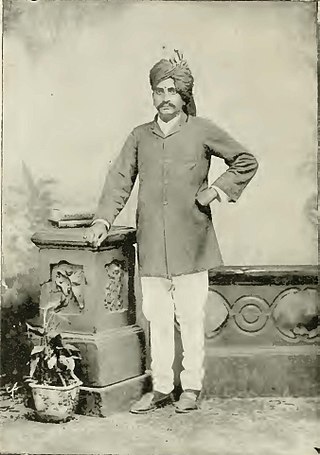
The Dhulap family was a Maratha noble warrior family of the Maratha Empire in the 18th century-early 19th century who were hereditary sarkhels or supreme commanders of the Maratha Navy till its decline in 1818. They came to power after the Angre family's downfall and Tulaji Angre's defeat at the Battle of Vijaydurg by the East India Company. Rudraji Dhulap and his son Anandrao Dhulap successively served as grand admirals of the Maratha Navy.














